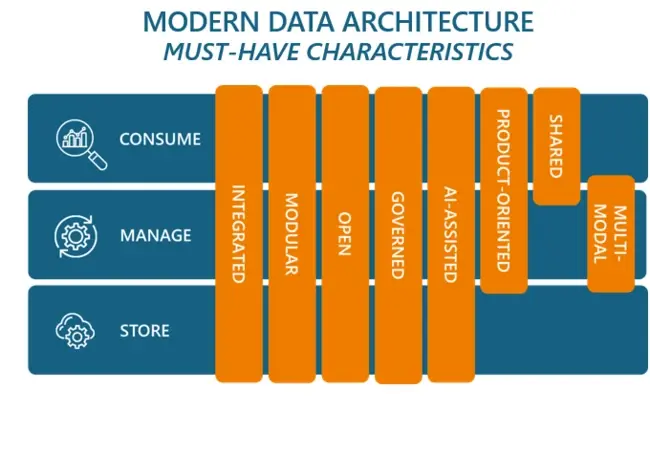To succeed with artificial intelligence (AI), enterprises need a modern data architecture that prepares, delivers, and governs multi-structured datasets. Such an architecture optimizes bleeding-edge technology while leveraging and integrating with traditional elements. It orchestrates data flows across distributed infrastructure that spans multiple data centers, regions, and/or clouds. A modern data architecture must be integrated, modular, open, governed, AI-assisted, product-oriented, shared, and multi-modal.

This report explores the following traditional and new elements of a modern data architecture.
- The storage layer includes traditional platforms such as relational database management systems (RDBMS) and enterprise data warehouses (EDWs), and new platforms such as data lakes, vector databases, and graph databases. Companies modernize their data architectures by adopting cloud-based storage platforms that integrate elements: for example, the lakehouse combines data warehouse and data lake technologies. In addition, data teams enrich AI model inputs and outputs by integrating functions and datasets across storage platforms.
- The data management layer comprises the traditional elements of data pipelines, master data management (MDM), cataloging, observability, and governance. Companies modernize this layer by adopting tools, often cloud-based, that integrate these functions and manage unstructured data. Many tools now use AI to automate and optimize data management.
- The data consumption layer comprises analytics projects that describe, predict, and prescribe business outcomes. With new technologies such as GenAI, they can generate content and take automated action. Consolidated toolsets simplify processes, expand the range of feasible projects, and develop applications that integrate two or more AI models.
Chief data officers and other data leaders should read the full report to learn guiding principles that will help them deliver business results as they address a wide range of use cases, including customer service, document processing, and regulatory compliance.
Download the report, sponsored by Informatica, here:
https://www.informatica.com/lp/upgrade-your-data-architecture-for-ai-breakthroughs_5050_archb.html







Comments ( 0 )